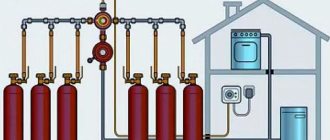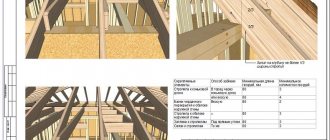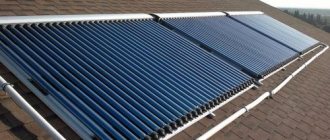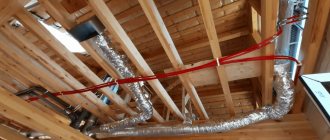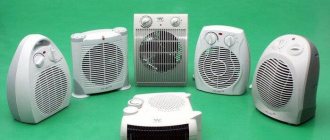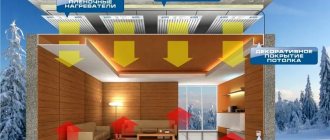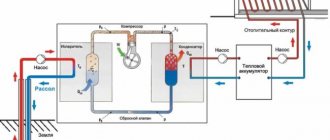On the modern heating equipment market you can find a wide range of equipment. Let's look at what a convector type heater is. Let's get acquainted with the features of radiators regarding connection, heat source and connection features. Read to the end and you will learn about the criteria that need to be taken into account before making a final decision to make your home comfortable and safe.
Floor convection heater Source bricomarche.pl
Warmth is the main joy in the cold season
Radiators - accumulate thermal energy received from the coolant, and then release it into the surrounding air.
You should approach this issue carefully: familiarize yourself with all possible market offers, choose the optimal price-quality ratio
It is necessary to take into account the layout and purpose of the room, the time people spend in the room with the heating device, as well as the location of the heater installation
To make the task easier, we will introduce you to the most popular and inexpensive heating options, namely convectors and radiators. The devices have stood the test of time and rightfully occupy a leading position among heaters. Let's consider the general characteristics of these heating devices, the principle of operation, as well as the pros and cons of each option. Let's try to determine what is better, more profitable and more reliable. Before we start choosing a heating device, let’s figure out how a radiator differs from a convector.
Heating devices - brief description
Radiator - serves to heat the room, operates on the principle of circulating water or antifreeze, in other words, it emits infrared radiation. As a rule, it is installed under the window, as it creates a “thermal plug” that does not let the cold into the room. A radiator is a structure consisting of several sections or panels, on which the amount of incoming heat and heat transfer depend. Previously, cast iron batteries were considered common, but progress has led to the widespread replacement of cast iron with aluminum.
A convector is a heating device that operates on the principle of convection: under the influence of a heating element, hot air is forced into the room, and cold air takes its place. That is, convection devices thoroughly mix the air layers of the room, thus creating the effect of a fan heater. This device consists of plates that pass air flows through them due to temperature differences, as well as channels, which are a key element, since the coolant passes through them. When using it, the heating of the air is 70-75%.
Disadvantages and advantages of heating devices, their differences
First of all, the difference between a convector and a radiator is the type of design and ribbing of the pipes, which significantly increases heat transfer. In addition, copper and aluminum are used in the manufacture of heating elements, which prevents metal corrosion. To operate the device, you need from 0.5 to 1 liter of water, which significantly saves energy costs. Light weight and simple design ensure ease of installation.
It is known that radiators are more efficient in terms of heat transfer. Compared to convector heaters, heating the radiator uses almost the entire area, which ensures constant heating of the room. Another advantage of radiator devices is their power and environmental friendliness, namely, air purity.
Convector disadvantages:
- lead to the formation of drafts in the room due to air movement from bottom to top;
- design features lead to the accumulation of dirt;
- Due to the peculiarities of the operating principle - convection, dust is constantly chasing around the room.
Radiator cons:
Types of structures
There are several types of convectors. First of all, they are grouped based on the energy carrier used. In this case, a distinction is made between electric, gas and water convectors. Each of them has its own pros and cons. The most popular today is the electric wall-mounted heating convector. Therefore, it should be given more attention.
Electric convectors differ in the design of the heating element. They can be tubular, monolithic or needle-shaped. In the latter case, the heating element is made in the form of a thin plate on which a chromium-nickel thread is installed. This material instantly heats up and cools down. This is one of the cheapest types of electric convectors. They cannot be used in damp areas.
A tubular heating element (TEN) is a steel device in which a nichrome thread is installed. It is surrounded by a special heat-conducting substance. This is a fairly durable type of device.
Monolithic heating elements operate silently. Their body is characterized as solid cast. These devices are considered the most effective.
Operating principle of an oil cooler
Everything here is arranged quite simply. The oil cooler is a hermetically sealed reservoir filled with mineral oil. An electric heater is also located inside the structure. As a result of the operation of the heating element, the oil temperature rises, and then the walls of the tank heat up. The room is heated.
To prevent the oil from boiling, the system is equipped with a special sensor that controls the temperature. In addition, some models have horizontal control. This means that if the radiator accidentally tips over and the heating element is out of the oil environment, the automation will instantly turn off the device.
Oil radiators are very easy to use. No knowledge is required here. You just need to plug the plug into the outlet, press the power button and move the device closer. Some manufacturers equip their models with a timer that allows the device to automatically turn on at a certain time. This is very convenient if you want, for example, to return from work to an already well-warmed room. At the same time, the radiator remains turned off throughout the day and does not waste electricity.
What heats better, a convector or an oil radiator?
Significant differences in the operation of a convector from an oil radiator affect the thermal characteristics and thermal efficiency of the devices.
Thermal characteristics of oil radiators
The main advantage of an oil heater over an electric convector is its high heating temperature. If the radiator design has a fan heater, the room can be warmed up quickly enough.
The heater operates almost silently. The optimal solution would be to use a heating device in country houses. Maximum heating area 20-25 m².
Thermal efficiency of convectors
The convector is distinguished by a low heating temperature, no more than 60°C, creating a favorable microclimate. The device does not dry the air, but to warm up the room it will take longer than an oil radiator with a fan heater, but only if the heating element of the latter is heated to the required temperature. The performance of convectors is sufficient to provide heating of a room over 100 m².
The electric convector is distinguished by the best thermal characteristics and performance.
Frequently asked questions about electric convectors
To avoid any difficulties during the operation of the electric convector, it will be useful for the future owner of this device to receive answers to frequently asked questions about the operation of this device.
Which convectors demonstrate the greatest operating efficiency - high or low?
The efficiency of a device is not determined by its size. Power is the key factor here. The various form factors in which electric convectors are offered on the market are created in order to provide the opportunity for their convenient integration into the interior of premises.
Is leaving the device unattended dangerous for the owner?
There is no danger if you leave your home for a while with the convector running. The main thing is that the wiring installed in your apartment can withstand the power of all devices connected to the network. You don't have to worry about the rest.
Is it possible to use an electric convector as the main source of heating in a room?
In most cases, yes. Everything largely depends on the equipment model and recommendations of the manufacturer.
Is an electric convector suitable for heating a nursery?
Yes, it is quite. Many manufacturers of this equipment have models that are designed specifically for use in children's rooms. The devices have a streamlined shape , and the body is highly durable. The holes in such devices are small, so a child will not be able to put anything in there.
Convection principle
Convector radiators operate from various energy sources. But the principle of their operation is the same. The air heated by the convector rises, and the cold masses fall down. The same process occurs in nature. At the same time, cyclones and winds are formed.
Heated air currents rush to the ceiling in the room, as they are lighter. Cold masses are determined near the floor. This movement occurs naturally. Some devices provide additional ventilation, which speeds up heat exchange processes.
But a conventional convector battery independently circulates air masses in the room. This is a simple but reliable way to heat your home quickly and with minimal energy costs.
Savings by using an inverter unit
A unique innovative development that comes with the new line of Ballu convectors is the EVOLUTION TRANSFORMER SYSTEM control unit. Digital INVERTER technology expands the capabilities of the device with two additional options:
- SMART EYE option on the presence sensor meringue. The SMART EYE sensor monitors the situation in the heated room and puts the convectors into sleep mode if there are no people or animals in the room.
- SMART WI-FI option. Its key component is a removable element that allows you to control the system from anywhere in the world. The SMART WI-FI accessory allows you to combine several heating devices into one intelligent system. We are talking about a system capable of monitoring the status of each individual device and changing its operating parameters in accordance with programmed modes. In the case of a convector, these can be individual temperature values for individual zones of the room. All that is needed to set up custom SMART WI-FI settings is the SMART WI-FI working module itself and a special mobile application. After entering the necessary parameters into the device’s memory, the system can operate without requiring additional human control.
The functionality of both options is very similar to the functionality of a smart home. Their key tasks are: optimizing operating costs, quickly achieving the set temperature, and ensuring operational comfort while maximizing energy savings.
This is very eloquently reflected by the results of a comparative analysis of two different convectors - one inverter, with a digital INVERTER control unit, the other - conventional (with mechanical control).
| Convector power (kW) | Daily energy consumption of a convector with a mechanical control unit, kW | Daily energy consumption of an inverter with a digital INVERTER block, kW |
| 2 | 17,057 | 3,611 |
Features of the convector heating system
The operating principle of convector heating
The very first convector heating batteries were traditional stoves. Thermal energy from their surface is transferred to the room. In this case, natural convection of air flows occurs - with a higher temperature they rise upward, creating heat circulation.
However, the efficiency of their work remains extremely low - the efficiency indicator did not exceed 25-30%. Therefore, convector heating boilers have been developed that transfer energy more efficiently. For this purpose, their design includes additional convector surfaces that improve circulation and, accordingly, the heating rate of the house.
How does convector heating at home differ from conventional heating?
- No pipelines. This reduces the primary costs of organizing heating;
- Possibility of installing local heating points - autonomous radiators. Most often this is done for dachas or houses with a small area, or apartments;
- Operational regulation of energy consumption to optimize temperature conditions.
The disadvantages of such a system include the complexity of the organization for buildings with a large area. Even if you install convector water heating consisting of autonomous radiators, it is problematic to create a single control unit. But there are exceptions - modern gas convector heating boilers. These are common models that can be installed in piping systems. The parameters for choosing such boilers are the same as when designing traditional heating systems.
The amount of energy generated in convector-type heating devices directly depends on the area of the heat exchanger
This is what you need to pay attention to first.
Expert advice
The convector battery is selected taking into account the room conditions. All presented types of devices have different heat transfer. But in general terms, you can calculate the required power. If the ceilings in the room are of standard height (do not exceed 2.7 m), 1 kW is required for every 10 m² of area. In corner and basement rooms this figure increases.
Experts advise installing a convector under each window. If the ceilings are high, the convector power must be increased. If the heater will be used only in a certain room, it can be mounted on the wall. To be able to move the convector between rooms, the equipment must be equipped with wheels and stands.
Having considered what a convector battery is and what types there are, you can choose the best option for a heating device. Taking into account all the advantages and disadvantages, purchasing a durable and efficient heater will be easy.
Oil type heaters
These devices are very widely used to increase the air temperature in an apartment or house. Installing them is extremely simple; no special skills or knowledge are required. Plug the device into the outlet, placing it closer to the heated area - and you're done. Thanks to the simplest possible design, breakdowns of the device's electrical circuit are unlikely.
Several models of oil radiators - the one on the far left is equipped with a fan.
The design of the oil cooler is based on a metal reservoir with mineral oil poured inside it. The oil, in turn, contains a heating element. As a rule, a device of this type is equipped with a rheostat for temperature control, a compartment for the power cord and electrical protection against overheating. Sometimes the heater also has a sensor that detects deviation from the horizontal. This allows you to automatically turn off a device that has tipped over. Oil radiators are also splash-proof.
Oil radiators are equipped with a handle for easy movement around the apartment.
The heaters are equipped with swivel wheels.
The cord compartment is designed to store the power cable when not in use.
Advantages of the oil device:
- Low price;
- Quiet operation;
- Ease of movement over various distances, for example, from room to room.
To determine how much power the device will need to make the room warm, we will use the following rule. If the ceiling height does not exceed three meters, then to heat 10 square meters of space you need a radiator with a capacity of 1 kilowatt. Basically, similar devices are produced with a power range from 1 to 2.5 kilowatts.
The device usually has a thermostat that automatically sets the desired temperature, maintaining it at the same level. Models equipped with a timer are very convenient - it will turn on the heater at the appointed hour. For example, you can schedule heating for the morning or evening, when all household members arrive from work. Thus, the timer allows you to save a fair amount of electricity, which is very expensive today.
Heater with electronic control system.
Mechanical control system.
Criterias of choice
Taking into account the characteristics of each type of heating element, you can choose one that is suitable for the specified purposes or the room where it will be used. If heating speed does not matter, it is better to choose durable and reliable heating elements or monolithic heaters. At a higher price, they will be able to work for a long time.
For long-term operation and slight but constant heating of the air, preference should be given to a monolithic system. A developed heat exchanger allows you to save energy even during long-term operation of the device: it can be turned on at full power to achieve operating temperature or rapid heating and left to maintain the desired temperature at ½ power.
Radiators and gas convectors
If spot heating devices are sufficient to maintain the temperature in the room, it is recommended to install gas or electric convector-type heating. They consist of a heating element, a control unit and a combustion product removal system (gas models).
Electric heating convectors
Electric convector design
This is the easiest and fastest way to heat a house or apartment. The heating element is an electric heating element, the temperature of which is transferred to the body of the device. Using a system of slots, air freely penetrates inside the radiator, creating convection.
The most common models for convector heating systems have a tubular heating element with metal plates. This increases the heating area. But reviews talk about one drawback - extraneous sounds are heard during operation. The reason for this is the expansion of the metal of the plates.
To install convector heating batteries, the following conditions must be met:
- The cross-section of the electrical wiring must be designed for the maximum power of the device;
- It is recommended to install a separate RCD to prevent short circuits;
- According to safety rules, you cannot leave the convector on when no one is in the house.
You also need to take into account high energy costs. Therefore, if there is a gas main, convector heating radiators with a burner are chosen.
The cost of electric convectors ranges from 4,000 to 15,000 rubles
It is important to pay attention to the characteristics of the control unit, protection from water and the presence of automatic shutdown when tipping over
Gas heating convectors
Economical heating of a convector-type house can be done by installing gas models. They consist of a burner that is not located indoors. Air flow and combustion products removal are carried out through a coaxial chimney.
Unlike convectors for electric heating, gas models have large dimensions. This is due to the presence of a gas burner and a fairly large heat exchanger. To improve convection, some models install a fan to increase air exchange.
The average cost of gas convectors is 8000-12000 thousand rubles. Despite the large number of foreign brands, they prefer to purchase domestic analogues. They are better adapted to special operating conditions.
In what cases is the installation of convector heating at home justified? Reviews about it, the high cost of batteries and radiators indicate a balanced approach when choosing such a system. In most cases, it is relevant for small rooms and production workshops where it is necessary to provide zonal (selective) heating.
In the video you can familiarize yourself with the installation features of gas convectors:
Main settings
Having figured out what convector heating is, you should arm yourself with general information about its technical characteristics. The power of electric convectors is in the range of 0.8 -3 kW, weight - from 3 to 9 kilograms.
Electric convectors currently available for sale are divided into three groups:
- High (450-670 mm).
- Medium (up to 330 mm).
- Narrow (for skirting boards), 140-200 mm high.
Due to their parameters, high-type heaters are able to provide a significant level of convection. Skirting models are equipped with less powerful heating elements. To maintain the proper level of efficiency, they are given a large length (up to 2.5 m).
Difference between convection heater and radiator
The heating system only reminds itself with the arrival of cold weather. However, you need to prepare the sled in the summer. During the cold season, comfort indoors, be it a house, apartment or office, is vital. Heat supply is a serious issue, especially in the choice of radiators.
Designation
A heating device is a radiator in the middle of which a coolant (water, antifreeze) moves. The heating device returns heat to the room using infrared, in other words thermal, radiation. Heating of the room occurs from the window into the room. According to their design, heating devices are sectional, tubular and panel. The level of heating of the room depends on the number of attached sections or panels. Today, our usual cast iron sectional heating devices are being replaced with metal or bimetallic devices.
The material from which the radiator is made plays an important role in heat transfer
Heating device
The radiator design is a radiator that transfers heat using convection. Convection is a physical phenomenon in which air flows through the heater, increases in volume and enters the space of the room, while cooler air occupies the free space. Air circulation occurs in a real way, creating a temperature difference. In the design of a convector heater, the important elements are: a channel through which the coolant moves, and grates or plates through which air passes.
Radiator design to contents ^
When comparing heating devices and convector heaters, let’s turn our attention to the places of their use. So, for example, water heating radiators are perfect for office and industrial premises with an increased glazing area, and also with a very high level of moisture (greenhouses, semi-houses, semi-gardens, swimming pools)
Panel radiators made of steel are very often installed in cottages and cottages. To heat apartments in houses with centralized heating, today it is proposed to install bimetal radiators.
It is believed that in terms of heat output, heating devices give off more heat than convector heaters. This is due to the surface area, which is involved in the heat transfer process. Heating devices provide more constant heating of the air, and convector heaters can create a draft in the room. This phenomenon occurs due to the movement of air from bottom to top. And if the device does not cover the width of the window, then the air also moves from the window into the room. From a safety point of view, convector heaters are considered less hot than, say, a cast iron radiator. But due to the properties of the structure, dust collects in the design radiators.
Conclusions TheDifference.ru
- The heating device has a very high heat output;
- The heating device is more economical to operate; the radiator design requires more heat input;
- A heating device will cost much more than a radiator design;
- The heating device is more environmentally friendly, the design of the radiator collects and drives away dust;
- The heating device is more powerful and larger; the radiator design is more compact and can be built into walls and floors.
Self-installation
You can install gas equipment in a private home with your own hands, but to do this you need to have all the necessary tools and have certain skills.
The following materials and tools are used during the work:
- metal-plastic pipe with fittings;
- pipe cutter;
- wrench;
- sanitary silicone;
- gas tap;
- perforator with a “spatula” crown;
- drill with drill bit;
- crosshead screwdriver;
- high-temperature polyurethane foam and silicone;
- dowels and screws made of plastic.
Stages of installation work:
- First you need to decide where the gas appliance will be installed. According to GOST, it is mounted under the window.
- The convector is fitted to the selected location. You can use a tape measure and transfer the dimensions, or simply attach the unit to the wall and mark the locations of future holes.
- Let's look at where the gas inlet is located. If at the bottom of the device, then you need to leave enough space for the supply of a pipe with a fitting.
- A hole is punched in the wall along the diameter of the exhaust pipe. This can be done with a hammer drill. This procedure is not only labor-intensive, but also dusty, so it is recommended to cover things with film in advance.
- Holes are drilled and dowels are hammered into them.
- The exhaust pipe is inserted into the convector. The joint should be treated with high-temperature silicone. After the pipe is inserted into the wall, the convector is secured using self-tapping screws.
- A gap is sealed between the pipe and the wall. This can be done conveniently using high-temperature foam.
- A special cap, included in the package, is installed at the end of the pipe. It prevents the burner from going out due to wind. Self-tapping screws are used to secure it.
Procedure for gas supply:
- The pipe leading to the heating device must be laid outside. This is the requirement of GOST. If the gas pipe already has a threaded connection, then just screw the tap onto it and shut off the gas supply to the convector. If there is no withdrawal, then one will have to be made. To perform this work, it is necessary to invite an electric and gas welder.
- After installing the gas tap, a metal-plastic pipe is connected to the convector. You can calculate its length using a tape measure.
- When laying the pipe, every meter should be secured with clips, for which you will need to drill holes in the wall.
- Installed fittings, like pipes, are lubricated with silicone, which provides additional sealing and facilitates installation work.
Now you need to check how the equipment works by doing a test run:
- The gas valve is opened and a soap solution is applied to all fittings and connections. Inflating bubbles will indicate a leak. If any are found, the tap should be turned off and the problem fixed.
- Next, the convector starts up. The gas supply button is pressed for about a minute, during which the gas will pass through all the pipes and end up in the combustion chamber.
- The piezo igniter is pressed, causing a spark to form in the firebox and ignite a flame.
- The device is adjusted so that the room temperature is comfortable.
At first after starting, you may notice an unpleasant smell of burning oil. This is normal - this is how the camera burns on new devices. If the smell persists for a long time, you need to check the quality of the joint between the exhaust pipe and the outlet of the device.
Comparative table of technical characteristics of oil and covector heaters
| Options | Oil heater | Convector heater |
| Economical | - Low economical. | +Approximately 25% more economical. |
| Heating time | + - Conventional models heat up for a long time, but those equipped with fans quickly. | —Heats the room for a long time. |
| Comfort to use | -Average. | +Both floor and wall models are more convenient. |
| Safety | —High surface temperature (but there are models with a protective casing); If the operating rules are violated, there is a risk of explosion. | +The surface of the convector is not subjected to strong heating; can be left unattended. |
| Life time | -Average | +Big |
| Environmental friendliness | —Due to convection, it raises dust particles | —Due to convection, it raises dust particles |
And based on the totality of all this, when deciding whether to choose a convector or an oil heater, you can clearly conclude: of course, a convector. Lightweight, compact, silent and safe, these heating devices are gradually replacing heavy, short-lived devices filled with hot oil from apartments and offices. So we can say that oil heaters have almost become a thing of the past in the matter of heating rooms. The only thing is that models of oil heaters equipped with fans are able to heat the room somewhat faster, but the process of heating its surface itself remains long. See below for detailed materials on choosing these heaters.
(no votes yet)
Review of manufacturers
A convector battery, the price of which depends on many factors, can cost in the range from 2 to 20 thousand rubles. The simplest types of electric batteries have a minimal set of functions. Their cost is from 2 thousand rubles. But among the variety of models presented, experts advise choosing electric convectors with TEN or monoblock. Devices from the Electrolux, Polaris, and Ensto brands have proven themselves well.
A gas convector will cost more. Its cost is from 13 thousand rubles. The most famous manufacturers of this type of equipment are Karma, ATON, Gorenje. Reviews about these manufacturers are more positive.
It should also be noted that the cost of the convector depends on the principle of its installation. Floor and wall models will cost much less than built-in equipment.

